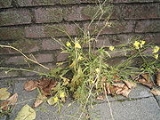
Diplotaxis tenuifolia
Encyclopedia
Diplotaxis tenuifolia is a species of flowering plant in the mustard family
known by the common name perennial wall-rocket. This plant is native to Europe and Western Asia. It can be found throughout much of the temperate
world where it has naturalized
.
This is an erect mustard-like plant with branching stems that may exceed half a meter in height. It grows in clumps on the ground in a variety of habitats and is a common weed of roadsides and disturbed areas. It has long leaves which may be lobed or not. The foliage is aromatic when crushed. Atop the branches of the stem are bright yellow flowers with four rounded petals each about a centimeter long. The fruit is a straight, flat silique
up to five centimeters long.
Brassicaceae
Brassicaceae, a medium sized and economically important family of flowering plants , are informally known as the mustards, mustard flowers, the crucifers or the cabbage family....
known by the common name perennial wall-rocket. This plant is native to Europe and Western Asia. It can be found throughout much of the temperate
Temperate
In geography, temperate or tepid latitudes of the globe lie between the tropics and the polar circles. The changes in these regions between summer and winter are generally relatively moderate, rather than extreme hot or cold...
world where it has naturalized
Introduced species
An introduced species — or neozoon, alien, exotic, non-indigenous, or non-native species, or simply an introduction, is a species living outside its indigenous or native distributional range, and has arrived in an ecosystem or plant community by human activity, either deliberate or accidental...
.
This is an erect mustard-like plant with branching stems that may exceed half a meter in height. It grows in clumps on the ground in a variety of habitats and is a common weed of roadsides and disturbed areas. It has long leaves which may be lobed or not. The foliage is aromatic when crushed. Atop the branches of the stem are bright yellow flowers with four rounded petals each about a centimeter long. The fruit is a straight, flat silique
Silique
A silique or siliqua is a fruit of 2 fused carpels with the length being more than three times the width. The outer walls of the ovary usually separate when ripe, leaving a persistent partition...
up to five centimeters long.

